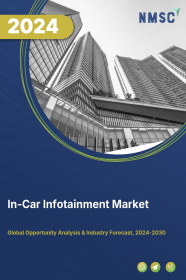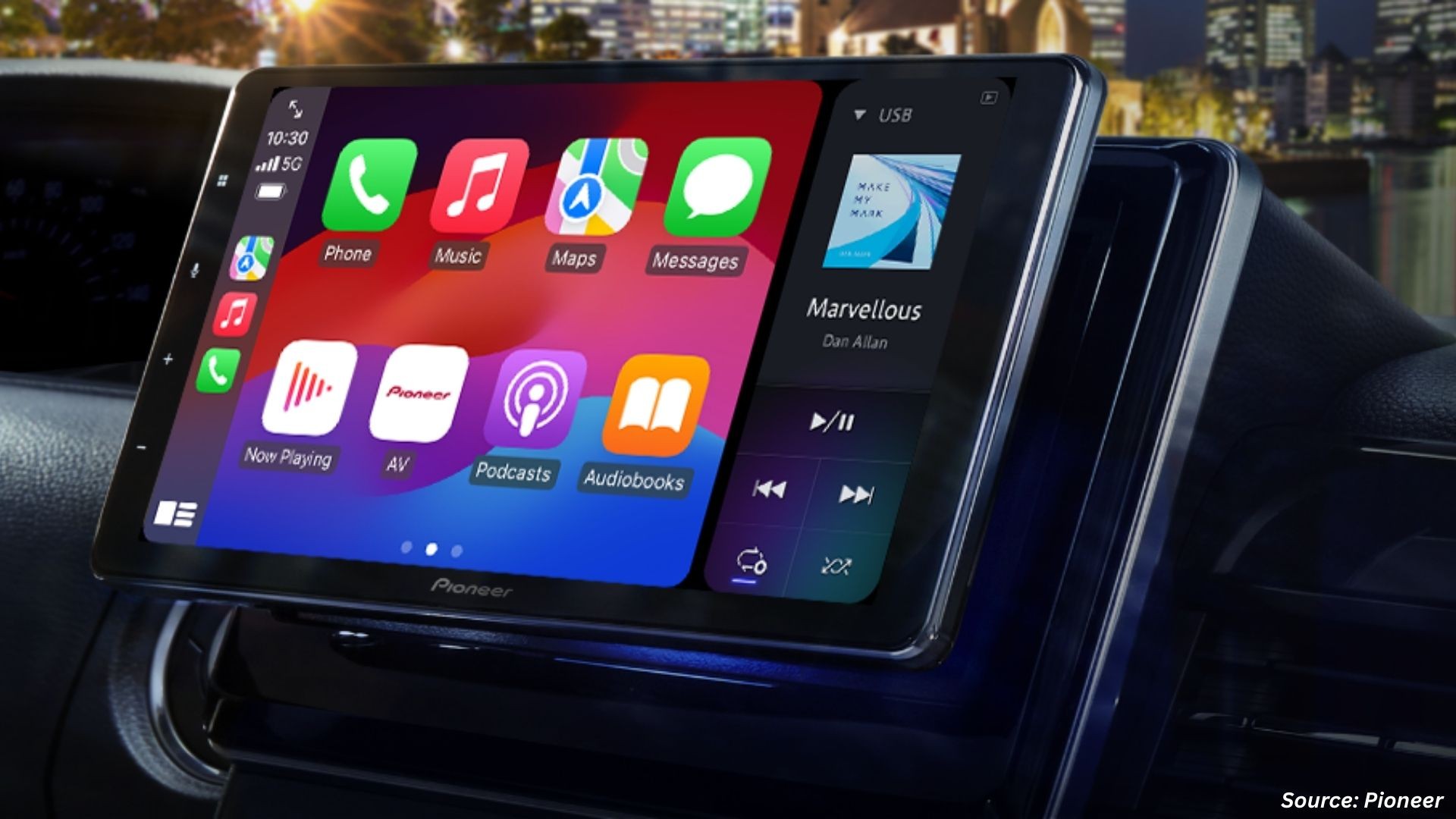
In-Car Infotainment Market by Offering, (Hardware, Software, Services), by Vehicle Type, (Passenger Cars, Light Commercial Vehicles, Heavy Commercial Vehicles, Electric Vehicles), by Fit Type, (OEM Fitted, Aftermarket), by Form Type, (Embedded Systems, Tethered Systems, Integrated Systems) - Global Opportunity Analysis and Industry Forecast 2024-2030
Market Definition
The global In-Car Infotainment Market size was valued at USD 16.4 billion in 2023 and is predicted to reach USD 35.4 billion by 2030 with a CAGR of 11.6% from 2024-2030. In-car infotainment refers to the integrated vehicle system that provides occupants with entertainment, information, and connectivity features. It encompasses a range of technologies and functionalities, including touchscreen displays, audio systems, navigation systems, smartphone integration, internet connectivity, and voice recognition.
Car infotainment systems have become increasingly sophisticated over the years, offering users a seamless and intuitive interface to access a variety of multimedia content, communicate hands-free, and navigate to their destinations. Car infotainment plays a crucial role in enhancing the overall driving experience, improving safety, and meeting the demands of modern consumers for connectivity and convenience while on the road.
Market Dynamics and Trends
The increasing adoption of automobiles worldwide drives the demand for the in-car infotainment market. As more consumers purchase vehicles, there is a growing expectation for advanced connectivity, entertainment, and navigation features within the car. This trend is fueling the need for in-car infotainment systems that offer seamless integration with smartphones, access to multimedia content, and real-time navigation services, among other functionalities.
Moreover, the growing adoption of rear-seat infotainment systems in cars, offering a range of multimedia features such as streaming video, music, and games, as well as access to the internet, social media, and other online services, is fueling the expansion of the in-vehicle infotainment market.
Additionally, there is an increasing demand for in-vehicle infotainment systems with large screens and more advanced functionalities. These systems enable advanced navigation systems, real-time traffic updates, and other features, further driving the market growth.
In addition, the growing integration of in-vehicle infotainment systems with advanced driver assistance systems (ADAS), including parking sensors, collision avoidance systems, and lane departure warnings, is further propelling the market growth. This integration enhances the overall driving experience by providing drivers with not only entertainment and connectivity features but also advanced safety functionalities.
By combining infotainment and ADAS technologies, vehicles become more intelligent and capable of assisting drivers in various driving scenarios, thereby increasing their appeal to consumers. As a result, the demand for in-vehicle infotainment systems with integrated ADAS features continues to rise, driving the growth of the market.
However, high cost of in-vehicle infotainment system and safety concerns are the major factors restraining the growth of the market. On the contrary, the introduction of advanced human-machine interfaces (HMI) aimed at reducing driver distraction by offering a more intuitive and seamless interface for controlling the vehicle's infotainment system is anticipated to create significant opportunities for growth in the in-vehicle infotainment market. These advanced HMIs leverage technologies such as gesture control, natural language processing, and augmented reality to simplify the interaction between drivers and infotainment systems, thereby enhancing safety and user experience.
Market Segmentations and Scope of the Study
The in-car infotainment market share is segmented on the basis of component, product type, operating system, fit type, by service, vehicle type, and region. On the basis of component, the market is divided into hardware and software. On the basis of product type, the market is classified into audio unit, display unit, control panel, navigation unit, telematics control unit, and head-up display. On the basis of operating system, the market is segmented into Linux, QNX, Microsoft, and others.
On the basis of fit type, the market is divided into OE fitted and aftermarket. On the basis of services, the market is classified into entertainment, navigation, e-call, diagnostics, and others. On the basis of vehicle type, the market is divided into passenger cars and commercial cars. Regional breakdown and analysis of each of the aforesaid segments include regions comprising of North America, Europe, Asia-Pacific, and RoW.
Geographical Analysis
North America holds the dominant share of in-car infotainment market and is expected to continue its dominance during the forecast period. This is attributed to factors such as the growing adoption of electric vehicles in countries such as the US and Canada.
As per the latest report published from the Argonne National Laboratory, the demand for PHEV is growing significantly, with more than 1.4 million EVs and PHEVs being sold in 2023, an increase of 50% from 2022. This surge in the demand for EVs and PHEVs is anticipated to boost the demand for in-car infotainment market in this region.
Moreover, the presence of key players such as Ford Motor Company and Chevrolet plays an important role in the growth of the in-car infotainment market in this region. For instance, In February 2021, Ford Motor Company entered into a partnership with Google to develop a highly advanced voice-recognition enabled infotainment system. Through this launch, the company aimed to provide a number of services such as Google Assistant, Google Maps, and Google Cloud in car infotainment in Ford’s system.
On the other hand, Asia-Pacific is expected to show a steady rise in the growth of the in-vehicle infotainment market. This is due to the growing automotive industry in countries such as China, Japan, and India. According to the International Trade Administration, China is the largest vehicle manufacturing country in the world selling over 25 million vehicles were sold in 2020 and domestic production is expected to reach 35 million vehicles by 2025. This presence of robust automotive industry in this region boosts the demand for in-car infotainment in this region.
Moreover, the growing disposable income in countries such as India, China, and Japan is further driving the demand for luxury cars equipped with advanced in-car infotainment systems such as GPS navigation, hands-free calling, and entertainment options, is driving the growth of the in-vehicle infotainment market.
According to the State Council Information Office of the People's Republic of China, the per capita income in China reached USD 5487 in 2022, an increase of 5% year on year. This rise in the disposable income in this region is driving the demand of luxury automotives, driving the growth of the market.
Competitive Landscape
Various market players operating in the in-car infotainment industry include HARMAN International Industries, Incorporated, Robert Bosch GmbH, Continental AG, Panasonic Automotive Systems Co., Ltd, Visteon Corporation, DENSO Corporation, Aptiv PLC, Hyundai Mobis Co., Ltd, LG Electronics Inc, Alpine Electronics, Inc, Pioneer Corporation, JVCKENWOOD Corporation, Sony Group Corporation, Garmin Ltd, Clarion Co., Ltd. (Faurecia Clarion Electronics), and Others. These market players are adopting product launches to remain dominant in the in-car infotainment/in-vehicle infotainment market.
For instance, in May 2025,HARMAN International IndustriesHARMAN announced it has become one of the first to open-source a complete connected services platform in collaboration with the Eclipse Foundation. This initiative aims to accelerate the development of software-defined vehicle experiences.
Moreover, in July 2025, Robert Bosch GmbHBosch is driving innovation in Head-Up Display (HUD) technology through its focus on user-centric design and data integration capabilities, enhancing vehicle infotainment systems.
Key Benefits
-
The report provides quantitative analysis and estimations of the in-car infotainment market from 2024 to 2030, which assists in identifying the prevailing market opportunities.
-
The study comprises a deep-dive analysis of the current and future in-car infotainment market trends to depict prevalent investment pockets in the market.
-
Information related to key drivers, restraints, and opportunities and their impact on the in-car infotainment market is provided in the report.
-
Competitive analysis of the players, along with their market share is provided in the report.
-
SWOT analysis and Porters Five Forces model is elaborated in the study.
-
Value chain analysis in the market study provides a clear picture of roles of stakeholders.
In-Car Infotainment Market Key Segments
By Offering
-
Hardware
-
Audio Unit
-
Display Unit
-
Heads Up Display
-
Navigation Unit
-
Communication Unit
-
-
Software
-
Operating System Licenses
-
Middleware And Platform Software
-
Application Software
-
-
Services
-
Navigation Services
-
Media And Entertainment Services
-
Telematics And Diagnostics Services
-
Over The Air Update Services
-
By Vehicle Type
-
Passenger Cars
-
Light Commercial Vehicles
-
Heavy Commercial Vehicles
-
Electric Vehicles
By Fit Type
-
OEM Fitted
-
Aftermarket
By Form Type
-
Embedded Systems
-
Tethered Systems
-
Integrated Systems
By Region
-
North America
-
The U.S.
-
Canada
-
Mexico
-
-
Europe
-
The UK
-
Germany
-
France
-
Italy
-
Spain
-
Denmark
-
Netherlands
-
Finland
-
Sweden
-
Norway
-
Russia
-
Rest of Europe
-
-
Asia Pacific
-
China
-
Japan
-
India
-
South Korea
-
Australia
-
Indonesia
-
Singapore
-
Taiwan
-
Thailand
-
Rest of Asia Pacific
-
-
RoW
-
Latin America
-
Middle East
-
Africa
-
Key Players
-
HARMAN International Industries, Incorporated
-
Robert Bosch GmbH
-
Continental AG
-
Panasonic Automotive Systems Co., Ltd.
-
Visteon Corporation
-
DENSO Corporation
-
Aptiv PLC
-
Hyundai Mobis Co., Ltd.
-
LG Electronics Inc.
-
Alpine Electronics, Inc.
-
Pioneer Corporation
-
JVCKENWOOD Corporation
-
Sony Group Corporation
-
Garmin Ltd.
-
Clarion Co., Ltd. (Faurecia Clarion Electronics)
Report Scope and Segmentation
|
Parameters |
Details |
|
Market Size in 2023 |
USD 16.4 Billion |
|
Revenue Forecast in 2030 |
USD 35.4 Billion |
|
Growth Rate |
CAGR of 11.6% from 2024 to 2030 |
|
Analysis Period |
2023–2030 |
|
Base Year Considered |
2023 |
|
Forecast Period |
2024–2030 |
|
Market Size Estimation |
Billion (USD) |
|
Growth Factors |
|
|
Countries Covered |
28 |
|
Companies Profiled |
15 |
|
Market Share |
Available for 10 companies |
|
Customization Scope |
Free customization (equivalent up to 80 working hours of analysts) after purchase. Addition or alteration to country, regional, and segment scope. |
|
Pricing and Purchase Options |
Avail customized purchase options to meet your exact research needs. |

















 Speak to Our Analyst
Speak to Our Analyst

























